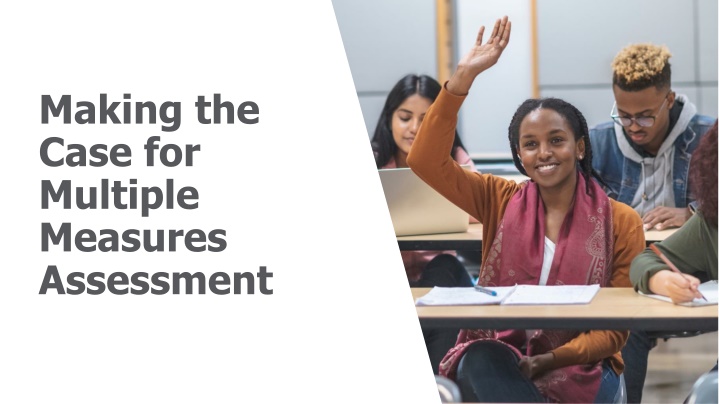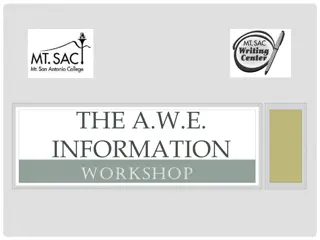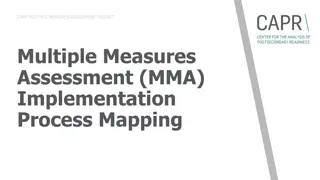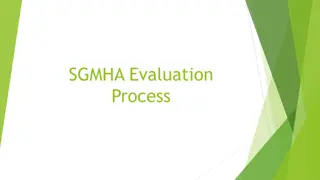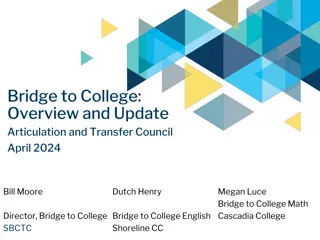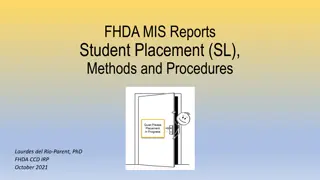Advancing College Placement through Multiple Measures Assessment
Colleges are transitioning from standardized tests to Multiple Measures Assessment for better student placement. Research indicates shortcomings of traditional placement tests and the benefits of using multiple indicators for college readiness. By expanding access and reforming developmental education, institutions aim to improve student success and reduce disparities in academic achievement.
Download Presentation

Please find below an Image/Link to download the presentation.
The content on the website is provided AS IS for your information and personal use only. It may not be sold, licensed, or shared on other websites without obtaining consent from the author.If you encounter any issues during the download, it is possible that the publisher has removed the file from their server.
You are allowed to download the files provided on this website for personal or commercial use, subject to the condition that they are used lawfully. All files are the property of their respective owners.
The content on the website is provided AS IS for your information and personal use only. It may not be sold, licensed, or shared on other websites without obtaining consent from the author.
E N D
Presentation Transcript
Making the Case for Multiple Measures Assessment
Colleges have traditionally used standardized tests to place students into courses Students arrive at college with different levels of academic preparation. Tests provide a simple and efficient way to place students into developmental or college-level courses. Typical tests include: Accuplacer and Compass SAT and ACT Homegrown tests
Placement tests are poor predictors of college readiness Research shows that placement test systems put many students into developmental courses who could succeed in college-level courses. Tests may reinforce cultural and racial biases. Test content may not align with what students need to know for their majors or careers. Source: Improving the Targeting of Treatment: Evidence From College Remediation
To improve placement, colleges are increasingly using multiple measures assessment (MMA) These colleges are considering several indicators of students readiness for college-level math and English, such as: High school GPA Standardized placement tests Background questions Course-taking history Other assessments The goal is to expand access to college courses by giving students several ways to demonstrate college readiness.
Expanding access helps students Research has shown that prerequisite developmental courses don t help many students prepare for success in college-level courses and sometimes hurt them, at least those near the college-level cutoff. Source: What We Know About Developmental Education Outcomes
Placement reforms are one part of a larger developmental education reform movement Traditional prerequisite approaches to developmental education delay enrollment in college-level courses, lengthen time to degree, and add to college costs. These negative effects disproportionately affect Black, Latinx, and low-income students. States and colleges are implementing corequisite support courses to replace prerequisite courses, revising math and English curricula, and taking other steps to reform developmental education.
Many colleges are introducing MMA and other reforms at the same time MMA is compatible with other developmental education reforms, such as corequisite courses and math pathways. In colleges that have eliminated prerequisite developmental courses, MMA can be used to place students into college-level courses with or without corequisite support.
Research on MMA
What does the research tell us about high school GPA?
High school GPA is the most predictive placement measure High school GPA has much more predictive power than any standardized placement test scores. Research shows that its predictive power holds up for several years after high school graduation and across high schools. 11th-grade GPA and self-reported high school GPA are nearly as predictive as final high school GPA and are more easily available. Combining additional measures with GPA can marginally improve predictive power, but a simple placement system can even use high school GPA alone. Source: Bostian, 2016; Hayward, 2020
High school GPA is more predictive than standardized placement tests From Bostian, 2016, North Carolina Waves GPA Wand, Students Magically College Ready; adapted from research of Belfield & Crosta (2012)
High school GPA is a better predictor than test results for a long time: English Source: Hayward, 2020
High school GPA is a better predictor than test results for a long time: Math Source: Hayward, 2020
Do differences in grading across high schools impact the reliability of high school GPA? Using data from North Carolina, researchers compared the difference between students average college GPA and their average high school GPA for students from the same high school district. Relative to students high school GPA, students college GPAs decreased by about the same average amount regardless of where students attended high school. These results suggest that differences across high schools should not be a major cause for concern when using high school GPA as a predictor of success in college-level English and math. Source: Bostian, 2016
What happens when MMA changes student placements?
Recent CAPR research on MMA: Study 1 One CAPR study examined an algorithm-based placement system at community colleges in the State University of New York (SUNY) that combined several measures into a formula that weighted them by predictive power. The measures in the algorithm included: Placement test scores High school GPA Years since high school graduation Students could be bumped up from developmental to college- level courses or bumped down from college-level to developmental courses. Many students placements stayed the same. Source: Evaluation of Alternative Placement Systems and Student Outcomes
Recent CAPR research on MMA: Study 2 A second study looked at a simpler systems of decision rules at community colleges in Minnesota and Wisconsin In the decision-rule systems, colleges considered: Placement test scores High School GPA LASSI or Grit scores Students who missed the cutoff for college-level courses on a placement test could qualify based on other measures No students were bumped down in Minnesota and Wisconsin Source: Multiple Measures Assessment Project
Increasing access to college-level courses using MMA improves outcomes Students in both studies who were bumped up from developmental to college-level courses were about 10 percentage points more likely to complete college-level courses after three semesters than similar students in the control group who were not bumped up. SUNY students bumped down from college-level to developmental courses were less likely to complete college- level courses.
College-level course completion rates for students bumped up via MMA compared with similar students placed in dev ed Note: Results from three semesters after placement. Source: Lessons From Two Experimental Studies of Multiple Measures Assessment
College-level course completion rates decreased for SUNY students bumped down to developmental courses Source: Who Should Take College-Level Courses? Impact Findings From an Evaluation of a Multiple Measures Assessment Strategy
MMA can improve equity English Enrollments and completions in college-level courses increased significantly for bumped-up students across all subgroups defined by race/ethnicity, gender, and Pell status Math In Minnesota and Wisconsin, enrollments and completions increased for bumped-up students In New York, men and students of color did not see significant impacts on completion of college-level courses
Recommendations based on the research Create an MMA system that: bumps many students up from developmental courses to college-level courses and avoids bumping students down emphasizes high school GPA and other transcript information, allowing the use of widely available measures such as self- reported high school GPA is relatively simple to implement, with decision rules based on cutoffs on a few measures Source: Lessons From Two Experimental Studies of Multiple Measures Assessment
MMA at our college
How will MMA affect you?
Process/procedural changes by role for: Faculty Advisors Administrators
Other questions?
